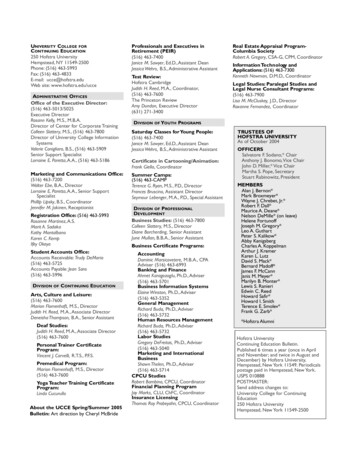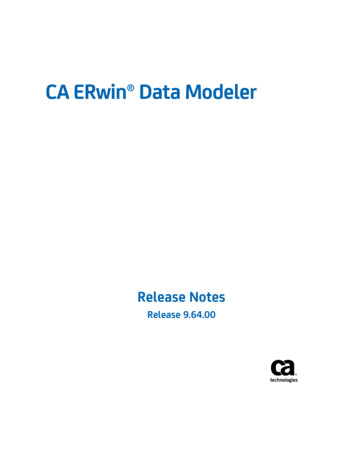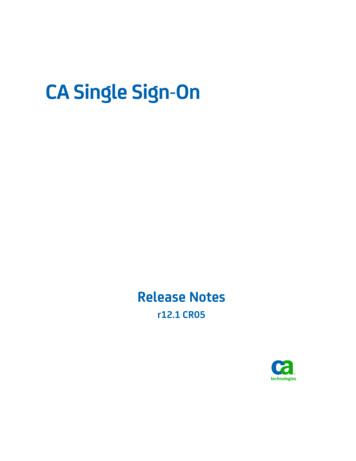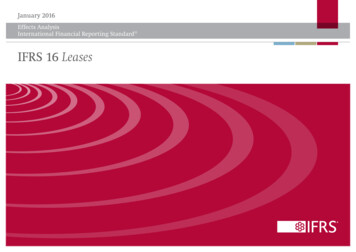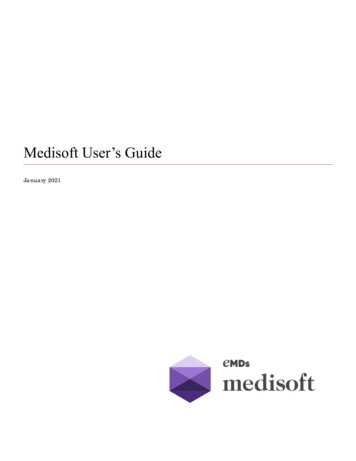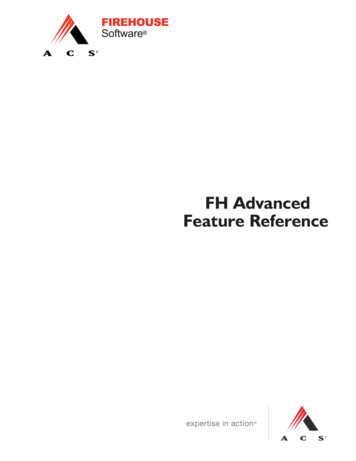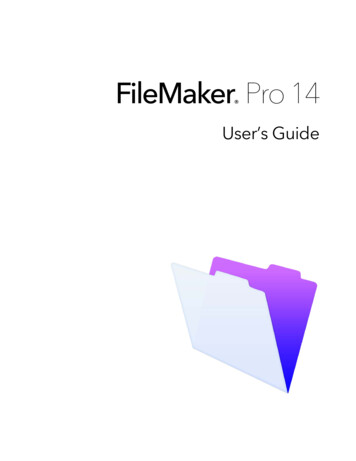
Transcription
2022 PRE-RETIREMENT GUIDEBlue Cross and Blue Shield Service Benefit PlanSEE HOW WE CAN HELP YOU PLANFOR A HAPPY, HEALTHY RETIREMENTfepblue.org
It’s never tooearly to startthinking aboutretirement.The earlier you start planning, the better off you’ll be.Whether your retirement is 30 years or 30 days away,on behalf of the Blue Cross and Blue Shield ServiceBenefit Plan, we want to thank you for your years offederal service.1
Think of the possibilitiesAfter years of hard work, retirement is a good time to focus on doing thingsthat you enjoy.Here are just a few of the things you can do:Develop new orexisting hobbiesand skillsTravelEnjoy more timewith familyand friendsFocus on yourhealth andwell-beingVolunteerContinue youreducationKnowing how you want to spend your retirement can help you better planfor the future today.2
Take care of yourself todayNo matter your age, taking care of yourself today may help youenjoy a longer, happier life after you retire. Staying up to date withyour preventive care could help you later in life.Make sure you:31See your primary doctor at least annually.2? now your numbers. Keeping your blood pressure, cholesterol,Kblood sugar and body mass index (BMI) under control can preventthings like heart attack and stroke.3Get other recommended screenings and tests. Screenings likecolonoscopies and mammograms can help identify potential healthproblems early when they’re easier to treat.4Maintain healthy eating, exercise and lifestyle habits.
Start planningAs we mentioned earlier, it’s never too early to start planning for retirement.Here are some tips for planning:1We recommend you start thinking about retirement at least five (5)years in advance. We’ll explain the five-year rule on page 11.2? on’t plan in a silo. If you’re married or in a committed relationship,Ddiscuss your plans with your significant other.3Talking to friends is good. However, know that everyone’s retirementneeds and plans are different. Know your individual options.4Take an inventory of your financial assets and needs.If you haven’t talked to a financial planner, you may want to.5Evaluate your health needs and think about possible future needs.Keep your family’s needs in mind, too.4
Evaluating your health needsWhen thinking about your health needs, you’ll want to consider what matters most.Keep in mind specific benefits and services that are important to you. Here are somethought starters.How important is it to:Have a large networkof providers?Have prescriptiondrug coverage?Know that you’re coveredif you go out of townor travel overseas?Be protected if youhave a catastrophicmedical event?The other thing to consider is cost.How much are you willing to pay for your coverage?5
6
Understand yourretirement benefit optionsOne of the best things about being a federal government employee is that you cantake many of your benefits into retirement with you.Insurance programs you can carryinto retirement include:1Federal Employees Health Benefits (FEHB) Program2Federal Employees Dental and Vision Insurance Program (FEDVIP)3Federal Long-Term Care Insurance Program (FLTCIP)4Federal Employees’ Group Life Insurance Program (FEGLI)If you’re currently enrolled in a flexible spending account, such asFSAFEDS, you will not be able to take it into retirement with you.7
Deciding whether to keepyour medical coverageShould I keep my government insurance when I retire,or should I look at different plans?What changes with my insurance when I retire?What is Medicare and how does it fit into my plans?We’ll give you some tools throughoutthe rest of this booklet to help youanswer these questions. Remember that,ultimately, when it comes to your healthand health insurance, the decisions areup to you.8
Keeping yourFEHB coveragewhen you retire.9
As a federal employee, you have some of the best medicalbenefits of anyone living in the U.S. When you retire, you get thesame benefits you get now as an actively working employee.Your premiums also don’t go up because you’re retired.Similar to now, you’ll still have the chance to review your options during theFederal Benefits Open Season (second Monday of November through the secondMonday of December) each year. You can also review them if you have a qualifyinglife event in which you would need to add or drop a dependent, such as amarriage or divorce.As long as you don’t cancel your insurance, it will never go away for as longas you’re retired. An important thing to note: If you do choose to cancel yourinsurance, you will never be able to re-enroll in the FEHB.If you want to try a non-FEHB plan, such as TRICARE, suspend your coverage.Don’t cancel it. For information on suspending your FEHB enrollment, contactyour retirement office.10
Here are some additionalthings to consider:To keep your medical coverage—you must have five (5) years ofcontinuous enrollment in the FEHB before you retire. This is knownas the five-year rule. This rule only applies to FEHB coverage—not to FEDVIP.The federal government will continue to pay a portion ofyour FEHB premium. They pay about 70% of the cost, and youpay the rest.You’ll pay your premium monthly. It usually comes out ofyour annuity.Your payroll office becomes the U.S. Office of PersonnelManagement (OPM). They will handle any questions or changesregarding your enrollment.If you die, your eligible surviving family members can keep yourcoverage. You must be enrolled in a Self One or Self & Familyplan at the time of death for this to apply.11
12
Medicare101Medicare is a health insurance program providedby the U.S. government to individuals: 65 and older With certain disabilities With End-Stage Renal DiseaseIf you sign up for Medicare and are still actively working,your FEHB plan is usually your primary coverage(meaning it pays first). If you’re retired, Medicare is usuallyyour primary coverage.13
The four parts of MedicareABMedicare Part A is hospitalinsurance. It covers inpatient,skilled nursing facility,home health and hospice care.Medicare Part B is medicalinsurance. It covers doctor’s visits,outpatient services, X-rays andlab tests, durable medical equipment,preventive services, physical andoccupational therapy and otherservices not covered by Part A.Most people don’t pay apremium for Part A.The standard premium in 2022for Part B is 170.10 per month.You may pay more or lessdepending on your income.CDMedicare Part C is a MedicareAdvantage plan. This is privatehealth insurance that helps tocover some of the things thatPart A and Part B don’t cover.Medicare Part D is prescriptiondrug coverage. Prescription drugcoverage is not included inMedicare Part A or Part B.Premiums for Part C plansvary by provider.Premiums for Part D plansvary by provider.14
Enrolling in MedicareYou cannot enroll in Medicare until you become eligible for it. For most people,your initial eligibility period begins three months before your 65th birthday. It endsthree months after your 65th birthday.If you receive social security benefits at least four months before turning 65,you’ll automatically be enrolled in Medicare Part A and Part B. Your coverage will startthe first day of the month of your 65th birthday (if your birthday is on the first ofthe month, your coverage will start the month prior to your birthday).If you are receiving social security benefits, you can opt out of receiving Part Bcoverage if you want. In order to opt out, you’ll need to follow the directions you’reprovided with your Medicare member ID card. You’ll receive the card three monthsbefore you turn 65.If you’re not automatically enrolled and don’t receive a Medicare member ID card,you can contact your local Social Security office. Learn more at ssa.gov.Enrolling in Medicare is a choice—you’re not required to sign up. With thatsaid, before you make a decision, youshould consider your future health needs.Even if you’re in perfect health now,health needs tend to change as we age.15
If I don’t sign up when I’m first eligible,can I sign up later?Yes. However, there are a few things to keep in mind:1You may pay a late enrollment penalty if you don’t enroll inMedicare Part B when you’re first eligible. ?The penalty is a 10% premium increase for each year youdelay enrollment. ?You also usually have to wait for the annual MedicareGeneral Enrollment Period (January – March) to sign upif you choose to enroll later.2The penalty doesn’t apply if you or your spouse is still activelyworking during your initial enrollment period and you chooseto keep your employer-sponsored health coverage. ?In this case, once you retire, you’ll have eight (8) months toenroll in Medicare without penalty. You can also sign up atany time while you’re still working.16
Combining Medicare Part Aand Part B with FEHB coverageBoth Medicare and FEHB provide great benefits. Choosing to combine them canoffer you even greater benefits.Closing Medicare gapsWhile Medicare Part A and Part B cover a lot, there are some thingsthey don’t cover. These are called “gaps.”Some of the gaps include: prescriptions, hearing aids, dental careand overseas care. Your FEHB plan may cover these services.Reduced out-of-pocket costsMany FEHB plans waive or reduce deductibles and copays whenMedicare is your primary coverage.For example, with Medicare Part A in 2022, there is a 1,556 deductible forinpatient hospital care. If you combine your coverage, your FEHB plan maypay that deductible for you.17
PremiumsAs we noted earlier, Medicare Part A is free for most people. Because of that,most federal employees/retirees take it as soon as they’re eligible.There is a premium for Medicare Part B. In 2022, it’s 170.10 per month formost people.If you combine your coverage, you’ll pay the Medicare Part B premium and yourFEHB plan’s premium.If you calculate the cost of both premiums, the overall annual cost of both can belower than your medical costs—especially as your health needs grow later in life.Additionally, some FEHB plans have benefits or programs that can help memberspay their Part B premiums.18
What about combining with FEDVIP?Medicare Part A and Part B don’t cover vision and dental care, but yourFEHB plan may offer some coverage. If you need additional coveragebeyond what your FEHB plan offers, enrolling in a FEDVIP dental or visionplan could be good for you. Similar to FEHB, FEDVIP dental and visionbenefits don’t change once you retire. You’ll pay your premium monthly.19
What about Part C?Medicare Part C is private insurance, also known as Medicare Advantage.It is an alternative to Original Medicare.These plans are offered by companies that contract with Medicare. These plansare “bundles” that include services that Part A, Part B and sometimes Part D cover.They may also include some additional services.You have different options for Part C plans, such as Preferred Provider Organizations(PPOs) and Health Maintenance Organizations (HMOs). The premium you’ll paydepends on the plan. The plans offered to you can vary based on where you live.What about Medicare Supplement plans?Medicare Supplement (or Medigap) plans are different from MedicareAdvantage. These independent plans are intended to supplement thecost of your Original Medicare coverage.Your FEHB plan is NOT Medigap coverage. However, similar to Medigap,your FEHB plan will cover gaps and coordinate with your Medicare plan.If you’re deciding between FEHB, Medigap and/or Medicare Advantage,you should look at the costs and benefits of each to see which is right foryou. Remember, if you cancel your FEHB coverage in retirement, you cannever re-enroll in the Program.20
What about Part D?Medicare Part D is private prescription drug coverage. You’ll pay a separatepremium for this coverage.Medicare Part A and Part B don’t cover prescription drugs. If you have those plansalone, you’ll pay the full cost of your prescriptions when you go to the pharmacy.If you keep your FEHB coverage and combine it with Medicare Part A and Part B,you don’t need to enroll in a supplemental drug plan, such as Medicare Part D.This is because your FEHB coverage pays out, on average, the same amount asa Medicare Part D plan.If you don’t keep your FEHB coverage, you’ll need to enroll in a plan that coversprescriptions, such as a Medicare Part D plan.Similar to Part B, there may be a penalty if you don’t sign up forPart D when you’re first eligible and decide you want it later.The penalty is 1 percent for each month you don’t have coverage.This penalty doesn’t apply if you’re covered in another plan thatoffers equivalent coverage, such as your FEHB plan. If you everlose your equivalent coverage, you’ll have 63 days to enroll in aPart D plan before the penalty kicks in.21
FinalthoughtsThe best way to decide to combine or not to combine is to determine whatyour needs are and what you think they may be in the future. Then, decideon your coverage based on those needs. You want to make sure your choicegives you peace of mind.If you want to know how your current FEHB plan combines with Medicare,you can reach out to them.If you’re a Blue Cross and Blue Shield Service Benefit Plan member,you can visit fepblue.org/medicare or call the customer service numberon the back your member ID card. If you have a different FEHB plan,you can go to their website or call customer service.Make sure you research or ask about:CoveringMedicare gapsWhether they waiveout-of-pocket costsif you combineyour coverageIf there are anyspecial benefits orincentives formembers who haveMedicare coverage22
Helpful ResourcesMedicareSocial SecurityVisit medicare.govVisit ssa.govCall 1-800-MEDICARE(TTY: 1-877-486-2048)Call 1-800-772-1213(TTY: 1-800-325-0778)OPMVisit opm.gov/retireNARFE(National Active and Retired FederalEmployees Association)BCBS FEPVisit fepblue.orgVisit narfe.orgCall 1-800-456-8410Stay connected to fepblueApple and the Apple logo are trademarks of Apple Inc., registered in the U.S. and other countries. App Store is a service mark of Apple Inc., registered in the U.S. andother countries.Google Play and the Google Play logo are trademarks of Google Inc.This is a summary of the features of the Blue Cross and Blue Shield Service Benefit Plan. Before making a final decision, please read the Plan’s Federal brochures (FEP BlueStandard and FEP Blue Basic: RI 71-005; FEP Blue Focus: RI 71-017). All benefits are subject to the definitions, limitations and exclusions set forth in the Federal brochures.The Blue Cross Blue Shield Association is an association of independent, locally operated Blue Cross and Blue Shield companies.The Blue Cross and Blue Shield words and symbols, Federal Employee Program , MyBlue , Blue365 and FEP are all trademarks owned byBlue Cross Blue Shield Association.SBPPGR2022
Insurance programs you can carry into retirement include: Federal Employees Health Benefits (FEHB) Program Federal Employees Dental and Vision Insurance Program (FEDVIP) Federal Long-Term Care Insurance Program (FLTCIP) Federal Employees’ Group
